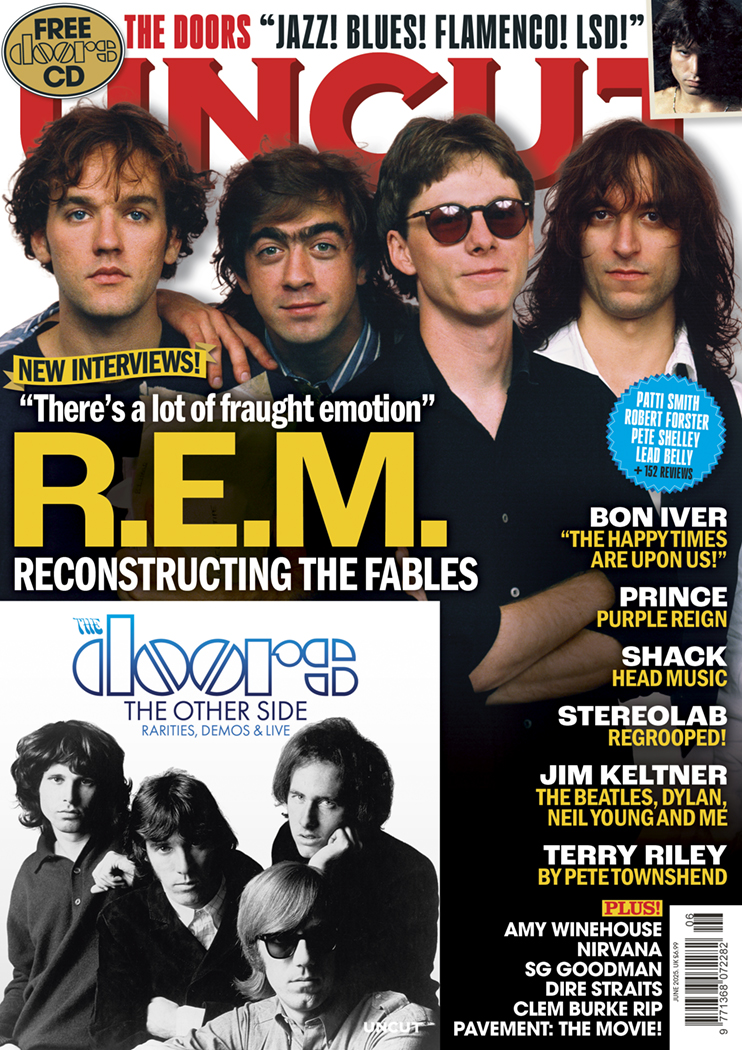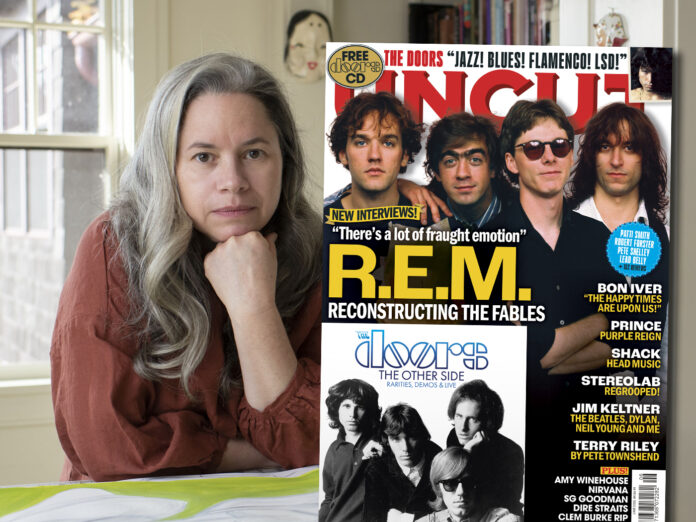Uncut interviewed Natalie Merchant for this month's cover story on R.E.M. Merchant first struck up a friendship with Michael Stipe, that continues to this day, during her time with 10,000 Maniacs, which included supporting R.E.M. on tour in 1985 and again in 1987.
Uncut interviewed Natalie Merchant for this month’s cover story on R.E.M. Merchant first struck up a friendship with Michael Stipe, that continues to this day, during her time with 10,000 Maniacs, which included supporting R.E.M. on tour in 1985 and again in 1987.
We didn’t have enough space for Natalie’s answers in the cover story, so here’s the email interview with her in full below.
UNCUT: You famously first met Michael at a house party in Athens; what were your first impressions of him?
NATALIE MERCHANT: I met Michael in early 1984 after a show that R.E.M. had played in a club in Atlanta, GA. Murmur had been out for a year and I can clearly remember the first time I heard it, and how it really floored me. I felt an instant kinship with the band and felt Michael and I were supposed to meet and become fast comrades. So, that first meeting carried a lot of weight in my mind. But as fate had it, we didn’t really get off to a great start. I had a vintage candy tin full of good luck charms that I carried in my shoulder bag and was showing Michael and explaining their meanings. He must have thought I was pretty tedious because he handed me a paper bag with his stuff in it and disappeared into another room — forever. The longer I waited, the more absurd I felt. Eventually, I put the bag on the floor outside the closed door and left the party. But a couple months later, I tried the mission again in Buffalo, NY. I took the bus to the city and showed up in the parking lot of the theater they were playing around soundcheck time. I knew where the vegetarian restaurant was and offered to show Michael. And instead of my box of trinkets, I impressed him with my juggling and penny whistle skills. I was only twenty and he was three years older. I can’t believe how long ago that was, that we’ve been friends for over 40 years. Jesus.
And what about the rest of REM; why do you think those early records are so important?
After the chaotic nihilism of punk and robotic synth nonsense that followed it was soul-restoring to hear the unpolished organic sound of this band. They were a four-piece that made a very distinct music due to their individual characters, their strengths and limitations. R.E.M. was a balance and sum of Peter’s jangly guitar loops, Mike’s driving bass riffs and irrepressibly poppy harmonies, Bill’s no-nonsense drumming, and Michael’s inscrutable yet meaningful gravely musings and mumblings. R.E.M. was atmospheric yet urgent, new yet mindful of tradition, there was something rural, out of the way, idiomatic, sort of southern gothic in the music they made. Their songs had echoes of a strange lost America while still sounding so contemporary. Their aesthetic was original (credit Stipe for that). They used creeping kudzu and outsider art in their cover designs. On stage, Peter would wear a corduroy Future Farmers of America jacket, and Michael, a crumpled baggy old brown suit in which he danced like a possessed Baptist preacher. I suppose they were original without being radical.
How do you characterise Michael’s development as a songwriter from Murmur through to Fables Of The Reconstruction?
In my view, Michael made a bigger leap as a songwriter between Fables and Life’s Rich Pageant. In Murmur and Fables, he was blending his voice into the mix more as a textural instrument. He stepped out of the shadows with the vocals on Pageant, he suddenly seemed to want to clarify his message, to be heard. That seemed to be the trend going forward with Document and Green, Out Of Time, Automatic For The People.
Are you a fan of Fables; if so, what qualities do you most admire about it?
My associations with Fables are unique and impossible to separate from my experience of listening to it (or any of those early R.E.M. records, for that matter). By coincidence, we had contacted Joe Boyd at the same time as REM to ask if he would produce our first major label album. Joe had been primarily focused on his label Hannibal, and producing world music for a decade but he agreed to do both our albums and booked our projects back-to-back. We arrived in London March of ’85 just as R.E.M. was finishing Fables. They vacated the studio and we started The Wishing Chair the next day, same studio, producer and engineers. We were all so young, the music makes me nostalgic and brings memories to the surface. It was a different world then, in so many ways.
What was the nature of the relationship between REM and 10,000 Maniacs?
R.E.M. was always ahead of us in their experience and in their popularity but they were always so supportive and kind to our band. They, and their management always gave us the best advice. In my friendship with Michael, I found someone I could talk about songwriting and performing, and all the pros and cons of a life spent on the road. I’m nothing but grateful for the association.
What do you remember about touring with REM in 1985?
The tour started in the western states (Colorado, Wyoming, Nebraska) then went through the endless flatlands of the Midwest (Iowa, Indianapolis, Ohio) and ended in the deep south (Louisiana, Alabama). You don’t have to know much about the geography of the U.S.A. to imagine the distance we covered in less than a month. Some of the drives were 10-14 hours long; my band and crew were crammed into one Econoline van. Eventually, Michael took pity on me and let me ride in their tour bus. The tour stands out in my mind because my band was still playing small trashy rock clubs and suddenly we were in landmark theatres and big college gymnasiums with a powerful sound system and lights. The scale of production was so much larger than anything I had yet seen. It was a supremely Cinderella experience. R.E.M. was just beginning to explode, when we toured with them again in ’87 on the Document tour, there were more buses, trucks, speaker’s and lights. It was quite an exciting to witness their assent and we were all so grateful they were sharing their success with lesser-known bands like ours.
Read the full R.E.M. cover story in the latest issue of Uncut – in shops now!




